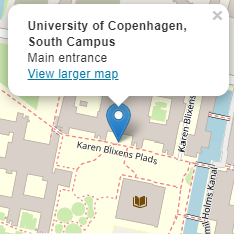Unliveable Spaces
Architecture and Violence in the West Bank
Runa Johannessen defends her PhD thesis.
Ph.d.-afhandlingen handler om de rumlige modstandspraksisser, som palæstinenserne har anvendt i kampen mod Israels voldelige annektering af palæstinensisk land gennem et halvt århundredes besættelse.
I den særegne politiske situation på Vestbredden fremstår arkitekturen som et våben, der kan anvendes taktisk både til kontrol og til dialektisk modstand mod fordrivelse. Arkitekturens grundlæggende gestus – at kontrollere og bebo et sted – spiller med andre ord en rolle i en konflikt, der dybest set handler om retten til en fremtid i landet.
Idet afhandlingen fastholder arkitekturen i dens dobbelte rolle som praksis og som objekt, undersøger den bygget struktur som agens, der instituerer og manifesterer territoriale kampe. Israel instrumentaliserer arkitekturen gennem en række gængse former for organisation af det kollektive rum og danner derved en særlig form for rumlig praksis, som denne afhandling foreslår at benævne som unplanning (“uplanlægning”).
Det er denne voldelige og udslidende praksis, der producerer unliveable spaces (“ulevelige rum”). På den anden side anvender de palæstinensere, der er bosat på palæstinensisk jord, en række taktiske værktøjer mod denne “uplanlægning” og dens ødelæggende virkninger. Nogle af disse værktøjer bruges til at imødegå besættelsen, andre anvendes med henblik på overlevelse i hverdagen. Tilsammen udgør de et spektrum af praksisser, som afhandlingen sætter sig for at undersøge som situativt formede handlinger.
Afhandlingens overordnede mål er at udfolde dette spektrum af praksisser. I en situation, hvor både kolonisatorerne og de koloniserede bruger arkitekturen som et taktisk våben til enten at udvide eller beskytte territorier, medfører besættelsens grundlæggende omskiftelige natur, at de koloniserede må forsøge at navigere rumligt i et territorium, der er i konstant bevægelse. Gennem casestudies af palæstinensiske rumlige praksisser, og gennem historiske og teoretiske overvejelser over magt, modstand og vold, vil afhandlingen vise, hvordan denne navigation via rumlig praksis indgår i et dynamisk forhold til besættelsen.
Derudover vil afhandlingen vise, hvordan denne navigation, gennem spekulation, forsøger at omgå eller overskride de restriktioner, der uophørligt producerer forhindringer for den palæstinensiske beboelse af palæstinensisk land. Afhandlingen foreslår, at der er vigtige fællestræk mellem den form for spekulation, der anvendes i forbindelse med hverdagens situative rumlige praksisser, og den spekulative forestillingskraft, der kommer til udtryk i de kunstneriske og aktivistiske praksisser, der beskæftiger sig med IsraelPalæstina-konflikten.
The thesis is concerned with spatial practices of resistance employed in Palestinian struggles against Israel’s violent dispossession of Palestinian land through half a century of occupation.
In the political configuration of the built space of the West Bank, architecture appears as a tactically deployed weapon of territorial control and a dialectical resistance to displacement. Standing in the position of being both a means to achieve an objective and the objective in itself, the elementary gestures of architecture — to control and inhabit a place — are employed in a conflict that concerns, fundamentally, who has the right to a future in this land.
By viewing architecture in its dual dimension of praxis and object, built structures are investigated as agents that induce and manifest territorial struggles. The spatial instrumentalisation of architecture is effected by Israel through commonplace civic practices of spatial organisation, forming a distinct category, in this thesis denoted as unplanning, and whose violent and attritional effect is the production of unliveable spaces.
Conversely, Palestinians inhabiting Palestinian land turn to a number of tactical tools against unplanning and its detrimental effects. Some of these tools are employed to challenge the mechanisms of the occupation, and others used for survival in everyday life. Together, these practices form a spectrum of practices that the thesis proposes to explore as situationally moulded acts. The main objective of the thesis is to unfold this spectrum: under circumstances where both coloniser and colonised deploy architecture as tactical weapons for expanding or, conversely, protecting land, the fundamental volatility of the order of occupation requires the colonised part to navigate a territory in constant movement.
Through case studies of Palestinian spatial practices, and historical and theoretical considerations on power, resistance, and violence, the thesis ventures to show how said navigation by means of spatial practices stands in a dynamic relationship with the occupation, yet also, through acts of speculation, attempts to exceed the restrictions given by a regime that ceaselessly produces obstructions to Palestinian inhabitation of Palestinian land. The thesis proposes that there is a common ground between the kind of speculation that is conjured in the mounting of situational spatial practices of the everyday, and speculative imagination evident in artistic and activist practices concerned with the Israel-Palestine conflict.
Assessment Committee
- Associate Professor Anne Ring Petersen, chair (University of Copenhagen)
- Dr Max Sternberg (University of Cambridge)
- Dr Nurhan Abujidi (Zuyd University of Applied Sciences, the Netherlands)
Moderator of the defence
- Associate Professor Henrik Reeh (University of Copenhagen)
Copies of the thesis will be available for consultation at the following three places:
- At the Information Desk of the Library of the Faculty of Humanities
- In Reading Room East of the Royal Library (the Black Diamond)
- At the Department of Arts and Cultural Studies, Karen Blixens Vej 1

